top of page

Welcome to Daniel Bastaja's
Hungarian Nature Photos
Hungary occupies the greater portion of
a geographical feature known as the Carpathian Basin - a massive drainage basin bounded by the Alps on the west, the Carpathian Mountains to the north and east, and the Dinaric Alps to the south. It is characterized by flat expanses, and the extensive grasslands and wetlands are one of the most ecologically important areas in Europe.

Follow me
 Great Grey ShrikeLanius excubitor ● The “butcher bird” is the winter shrike in Hungary, typically arriving after the summer shrikes like Red-backed and Lesser Grey have departed for Africa. The summer shrikes are primarily insectivorous, but since there are few bugs around in winter, the Great Grey is much more aggressive in going after small rodents and birds. |  European NightjarCaprimulgus europaeus ● The only nightjar found in most of Europe, it is highly migratory. This bird was found roosting in a park in downtown Budapest on October 05, which is late for this species. It was the second time I have seen nightjar in this park. |  Western Marsh HarrierCircus aeruginosus ● Female ● This species is the largest and bulkiest of the harrier clan. It used to be a summer bird in Hungary but with increasingly mild winters, it is now not so unusual to find them in the winter. |
|---|---|---|
 Pallas's GullIchthyaetus ichthyaetus ● Also known as the Great Black-headed Gull, this large gull is primarily an Asian species. Rare but regular in Hungary and can occur at any time of year. This bird is well advanced into breeding plumage. |  Great Crested GrebePodiceps cristatus ● The commonest grebe in Hungary. This one is in winter plumage, which is quite a bit duller than their breeding livery, except for the beak. In winter, the bill becomes a much brighter pink. Resident throughout the year, except if an exceptionally cold winter freezes all the open water. This, however, is rare. Most winters in recent years are quite mild. In winter, on large bodies of water like Lake Balaton, this is one of the most abundant water birds. |  Black-necked GrebePodiceps nigricollis ● Known as the Eared Grebe in North America, this small grebe is mostly a passage and winter bird in Hungary. It does breed on occasion but most of the European breeding takes place farther north. |
 Short-toed Snake EagleCircaetus gallicus ● A summer bird in southern Europe, wintering in Africa. As the common name suggests, its preferred prey is snakes. That may be why it has evolved such small feet for a raptor of this size. Makes it easier to grab skinny snakes. |  Black WoodpeckerDryocopus martius. A female beating up on a pine tree. Europe's largest woodpecker. |  Little EgretEgretta garzetta. The European counterpart to North America's Snowy Egret. |
 Wood WarblerPhylloscopus sibilatrix. One of the easier Phylloscopus warblers to ID. It looks like somebody grabbed it by the tail and dipped its head in butter. | 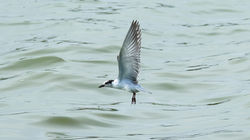 Whiskered TernChlidonias hybridus. The commonest of the three marsh terns found in Hungary. When it was first described by Pallas, he thought it was a hybrid between White-winged and Common Tern, hence the goofy specific epithet. |  GarganeySpatula quercedula. A small teal-like dabbling duck. This male is in fresh breeding plumage. Summer resident in Hungary, it spends the winter in sub-Saharan Africa and south Asia. |
 Ferruginous DuckAythya nyroca ■ Rétimajor, Hungary ■ A summertime visitor to Hungary, this diving duck prefers smaller, shallower freshwater lakes and ponds with lots of reeds. |  Great BustardOtis tarda ■ Bugyi, Hungary ■ As one of the heaviest flying birds, it takes a lot of effort for Great Bustards to stay airborne. You can see the huge breastbone which acts as an anchor to the flight muscles. Most large birds will flap and glide, flap and glide, but not bustards. They have too flap constantly or they would drop like a stone. |  BluethroatBluethroat Luscinia svecica ■ Apaj, Hungary ■ This tiny, colourful bird belongs to the same genus as the nightingales. In summer, it is found right across the northern palearctic and even into Western Alaska. It is highly migratory wintering in sub-Sahara Africa and India. In Hungary its preferred habitat is dense phragmites reed beds, where it is usually very hard to see. |
 Lesser Black-backed GullLarus fuscus ■ Apaj, Hungary ■ The nominate subspecies of the Lesser Black-backed Gull (L. fuscus fuscus), known as the Baltic Gull, is the commonest subspecies to occur in Hungary. It is primarily a passage bird, occassionally showing up in winter. |  Gray HeronArdea cinerea ■ Apaj, Hungary ■ The commonest heron in the Hungarian countryside. Looks very similar to North America’s Great Blue Heron, but is much paler on the back and neck and has white thighs (Great Blue Heron has reddish thighs). |  Eurasian SparrowhawkAccipiter nisus ■ Törökbálint, Hungary ■ I was watching the birds at my feeder when this hawk came blasting through and grabbed a Fieldfare (Turdus pilaris) right in front of my window. Fortunately I had my camera at the ready to capture this unfortunate moment for the thrush. The size and colouration indicates the hawk is likely a juvenile female. |
 Eurasian HoopoeUpupa epops ■ Csákvár, Hungary ■ This spectacular bird nests in holes and cavities in trees and forages on the ground for beetles, grubs and worms. There used to be only one Hoopoe species, but now the South African and Madagascar populations are officially recognized as separate species. |  Mute SwanCygnus olor ■ Solt, Hungary ■ Native to Europe, this swan has been naturalized in many other parts of the world. It’s not really mute, but much less vocal than other swan species. Its call is a soft, wheezy grunt. |  Greater Spotted CuckooClamator glandarius ■ Tihany, Hungary ■ This large cuckoo is primarily an African species that can be found in extreme southern Europe (Portugal, Spain, Italy, Greece, Turkey) during the summer. Very rare in Hungary with this bird being the first record in 18 years. |
 Great BustardsOtis tarda ■ Bugyi, Hungary ■ This is one of the heaviest flying birds in the world, with adult males reaching a whopping 18 kilos (40 lbs). It is classified as vulnerable due to widespread habitat loss. It has very patchy distribution in Europe with Spain and Hungary being the populations strongholds. |  Green SandpiperTringa ochropus ■ Rétszílás, Hungary ■ Unlike other sandpipers, this species is not very gregarious and is usually seen alone or in pairs. It is also the most likely to be found in smaller ponds with thick vegetation. It is strictly a passage bird in Hungary although a few can be found wintering if the weather is mild. In Western Europe, it is largely resident. |  Red Footed FalconFalco vespertinus ■ Solt-járás puszta, Hungary ■ A family group. From left to right, an adult female, adult male (with dragonfly) and juvenile. A summer bird in Hungary, they migrate all the way to southern Africa for the winter. In late summer, as they are fattening up for their long migration, dragonflies make up the bulk of their diet. |
 Snow BuntingPlectrophenax nivalis ■ Zámoly, Hungary ■ An uncommon but regular winter visitor to the Hungarian plains from the high arctic. Circumpolar in distribution. You can tell it’s a long-distance migrant by the primary extension. Birds that migrate long distances tend to have longer primary flight feathers. | 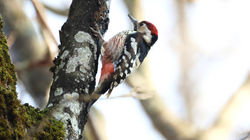 White-backed WoodpeckerDendrocopos leucotos ■ Királyrét, Hungary ■ Found from Central Europe and Scandinavia all the way to Japan, this woodpecker is becoming scarcer in the European part of its range due to habitat loss. It requires large tracts of mature deciduous forest. In Hungary, most of the biggest trees are cut down for lumber, even in the National Parks. |  Alpine AccentorPrunella collaris ■ Királyrét, Hungary ■ Here’s something you don’t see very often.… an Alpine Accentor in a tree. These are ground-dwelling birds. |
 Alpine AccentorPrunella collaris ■ Királyrét, Hungary ■ A small passerine resident in high mountain regions above the treeline in southern Europe and parts of Asia. In winter, small groups can be found in the lowlands in micro-habitats similar to what would be found in the mountains, such as rock quarries. |  Little GullHydrocoloeus minutus ■ Bugyi, Hungary ■ The world’s smallest gull species is strictly a passage bird in Hungary, but a few may show up during mid-winter or mid-summer. This is a first winter juvenile. |  European RobinErithacus rubecula ■ Budaörs, Hungary ■ A common resident in Hungary, this is the bird for which the American Robin is named, although this bird is not a thrush but belongs to the old world flycatchers. |
 Black RedstartPhoenicurus ochruros ■ Female ■ Budaörs, Hungary ■ This tiny flycatcher is common around human habitation for most of the year, only disappearing during the coldest winter months when it heads a short distance to Mediterranean coastal areas. As winters in Hungary have become progressively milder in recent years, more can be found in winter, where they survive on seeds and berries. |  WallcreeperTichodroma muraria ■ A small, palearctic bird of high mountain rock faces, it is found from southern Europe to China. It is uncommon but regular in Hungary during the winter when it moves to lower elevations. It is so unique that it is the only member of its genus and family. Ornithologists feel it is probably most closely related to the nuthatches. |  Yellow-browed WarblerPhylloscopus inornatus ■ Budapest, Hungary ■ This leaf warbler is a rare but regular fall visitor to Europe from Siberia. Hungary gets perhaps two to three records every autumn. |
 Little CrakeZapornia parva ■ Juvenile ■ Budapest, Hungary ■ Like all crakes, this species is very secretive and hard to see in the wild. Most often heard rather than seen. It is found in a different habitat than the Spotted Crake. Whereas the latter likes wet grass and sedge, the Little Crake prefers dense phragmites reed beds | 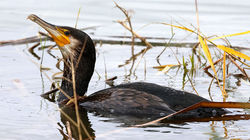 Great CormorantPhalacrocorax carbo ■ Apaj, Hungary ■ This is the most widespread of the world's cormorants, being found on every continent except South American and Antarctica. Their diet is almost exclusively fish and for this reason they often face persecution by fisherman. Commercial fish farms in Hungary are allowed to shoot them. |  Crested LarkGalerida cristata ■ Kunpeszér, Hungary ■ This lark loves bare dirt and freshly ploughed farm fields, but can also be found on the asphalt expanses of suburban shopping malls. It is resident through most of its range which encompasses Europe, North Africa and Central Asia. In Hungary it can be found year round, but much fewer in winter. |
 European RollerCoracias garrulus ■ Solt-járás puszta, Hungary ■ This large, powerful songbird often sits on wires or other exposed perches to scan for food. It primarily eats large bugs but will take anything it can catch and subdue including frogs, lizards, mice and small birds. Satellite telemetry has indicated that many of the Rollers summering on the Hungarian plains, winter in Botswana. |  European GoldfinchCarduelis carduelis ■ Kunpeszér, Hungary ■ A common resident finch in the European countryside, seen here feeding on hemp seeds. It is very partial to hemp and thistle. |  Eurasian Tree SparrowPasser montanus ■ Törökbálint, Hungary ■ Probably the commonest and most widespread sparrow in the world, it is found throughout Europe and Asia and has introduced populations in other parts of the world. In Hungary, it is far commoner than the House Sparrow and unlike the House Sparrow, it can be found far from human habitation. |
 European Turtle DoveStreptopelia turtur ■ Bugyi, Hungary ■ Europe-wide, this species has suffered a 78% population decline in the last three decades. Mostly due to habitat loss and intense hunting around the Mediterranean Basin. An estimated two to four million birds are shot annually in Spain, France, Italy, Malta, Greece, Cyprus, Turkey, Lebanon and Egypt. |  Sand MartinRiparia riparia ■ Délegyháza, Hungary ■ Known as the Bank Swallow in North America, this species has the second largest worldwide range of any swallow after the Barn Swallow. It is found on every continent except Australia and Antarctica. | 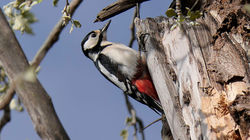 Great Spotted WoodpeckerDendrocopus major ■ Rétszílás, Hungary ■ The commonest woodpecker in Central Europe by a wide margin, you see dozens of these for every one of any other species. They are common in a wide variety of habitats, from deep, remote forests, to towns and villages and even on the steppe where there are a few bushes and trees around. |
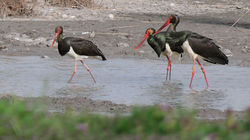 Black StorksCiconia nigra ■ Apaj, Hungary ■ Compared to White Storks, Black Storks are much less tolerant of human activity. Whereas White Storks nest in towns and villages, Black Storks prefer deep and secluded riparian forest for nesting. In Hungary this type of habitat is generally along the Danube River in the southern part of the country. |  White-throated DipperCinclus cinclus ■ Budapest, Hungary ■ Dippers are unique songbirds that dive and swim underwater to catch aquatic insects. Of the five species in the world, this is the only one found in Europe. They like fast rushing, rocky streams which is why they are usually found at higher elevations. Occasionally in winter they will come to lower elevations. |  Eurasian BullfinchPyrrhula pyrrhula ■ Male ■ Törökbálint, Hungary ■ The male Bullfinch has to be the most spectacular European finch. Its incredible colours and ability to imitate various whistling sounds make it a popular cage bird. It is resident throughout most of northern Europe, but in Hungary it is strictly a winter visitor where it is always found near ash trees. Ash keys are its favorite winter food. |
 RedpollAcanthis flammea ■ Budapest, Hungary ■ This is what used to be known as Lesser Redpoll until all three Redpoll species were lumped into one in 2024. This smaller and browner subspecies is found strictly in Europe. Rare in Hungary except during irruption years which occurs about every four or five years. |  Arctic LoonGavia arctica ■ Abádszalók, Hungary ■ Also known as the Black-throated Diver, this loon is a palearctic species with occasional vagrancy to North America. It is an uncommon but regular winter visitor to Hungary. The white flanks showing above the waterline is one diagnostic field mark that helps separate this species from the similar Pacific Loon. |  Western JackdawCorvus monedula ■ Budapest, Hungary ■ Europe’s pint-sized crow, the jackdaw is only about two-thirds the size of a regular crow. It has a very uncrow-like voice, sort of a high pitched, squeaky “kyow”. Unlike other corvids that build a platform nest, this bird is a hole and cavity nester. |
 Song ThrushTurdus philomelos ■ Uszod, Hungary ■ One of the commoner woodland thrushes in the summer, its song can be easily recognized because it repeats every note three times before moving on to the next one. |  Marsh WarblerAcrocephalus palustris ■ Budapest, Hungary ■ When singing, it is easy to distinguish this species from the very similar Reed Warbler. But when they are not singing, extremely difficult to separate under field conditions. Ringers often use things like the colour of the toes to separate them. |  Common NightingaleLuscinia megarhynchos ■ Budapest, Hungary ■ A small, relatively nondescript brown bird, that is hard to glimpse, as they like to stay under deep cover. But what a voice! Loud with such a rich tone. In the spring, they will sing all night long. In Hungary they arrive around mid-April and are gone by mid-September to winter in Africa. |
 Common SandpiperActitis hypoleucos ■ Szabadszállás, Hungary ■ This is Europe’s counterpart to North America’s Spotted Sandpiper. Unlike the latter species, it does not change plumage from summer to winter, remaining in the same livery year round. It is found in a variety of habitats usually near water and it is in perpetual motion, constantly bobbing up and down. |  Common QuailCoturnix coturnix ■ Budapest, Hungary ■ Other than the buttonquail found in southern Spain, this is Europe’s only quail species. A very common summer bird in the Hungarian countryside, but you never see them. They always stay well hidden, and their presence is only revealed by their characteristic three-syllabled ‘whit-whit-whit” call. They are also raised commercially for meat and eggs. | 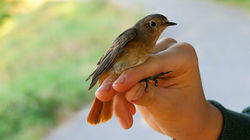 Common RedstartPhoenicurus phoenicurus ■ Juvenile ■ Budapest, Hungary ■ Despite the name, this redstart is uncommon in Hungary, being far outnumbered by the Black Redstart. Unlike its much commoner cousin, this species doesn’t have the same affinity for being around human habitation. |
 Reed warblersWarblers of the Acrocephalus genus (meaning “peaked head” in Latin) are collectively referred to as the reed warblers as they are generally found in dense Phragmites reed beds. Here are two of the commoner species. Left is European Reed Warbler (Acrocephalus scirpaceus) and right is Sedge Warbler (Acrocepahlus schoenobaenus). |  Short-eared OwlAsio flammeus ■ Dunavarsany, Hungary ■ These owls are crepuscular, meaning they are most active during the half-light of dawn and dusk, so I was surprised to find this one sitting out in the open on a bare tree on a really hot, sunlit afternoon. |  Little Ringed PloverCharadrius dubius ■ Dunaszentbenedek, Hungary ■ When this small plover was first classified in the 18th century, naturalists thought it was probably a variant of the Common Ringed Plover. Hence the specific epithet of “dubius” meaning doubtful. Its specieshood, however, has withstood the test of time. The bright yellow eye-ring is just one of the many features that separate it from the Ringed Plover. |
 Northern LapwingVanellus vanellus ■ Kisújszállás, Hungary ■ As the common name suggests this is the northernmost of the world’s 24 lapwing species. This large, noisy plover is a common breeder in European farmland and pastures. |  Wood SandpiperTringa glareola ■ Kisújszállás, Hungary ■ This medium-sized sandpiper prefers grassy, fresh water wetlands. During spring and fall migration, it is one of the commonest Tringa species in the Carpathian basin. The long, defined supercilium is one way to distinguish it from similar species such as Green or Solitary Sandpiper. | 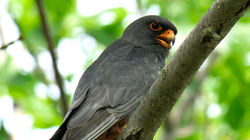 Red-footed FalconFalco vespertinus ■ Male ■ Solt-járás puszta, Hungary ■ About the size of a Eurasian Kestrel, Red-footed Falcons are strictly a summer bird in Central and Eastern Europe. They migrate all the way to southern Africa to spend the winter. They are primarily insectivorous, taking far fewer small mammals than do their cousins the kestrels. |
 Bearded ReedlingPanurus biarmicus ■ Male ■ Solt-járás puszta, Hungary ■ The most taxonomically unusual bird in Europe, it is not closely related to any other species. It is so unique that it has its own family (Panuridae) of which it is the only species. It is a common resident in Hungary in dense Phragmites reed beds. |  Eurasian Marsh HarrierCircus aeruginosus ■ Male ■ Solt, Hungary ■ Came across this sick harrier that had trouble flying. There were some dead gulls nearby so it made me suspect that it got bird flu from eating one of those. Or perhaps shot by a hunter or farmer. It is a protected bird but it does happen. | 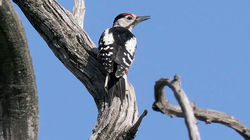 Syrian WoodpeckerDendrocopos syriacus ■ Solt-járás puszta, Hungary ■ Found in the SE corner of Europe and the Middle East in open country with a preference for parks and gardens around human habitation. Not often found in deep woods like Great Spotted Woodpeckers. It can be separated from that species by voice, face pattern and a pink vent compared to scarlet for the Great Spotted. |
 Barred WarblerCurruca nisoria ■ Male ■ Inárcs, Hungary ■ This and the Great Reed Warbler are the largest warblers in Central Europe, being almost the size of a small thrush. The Barred Warbler likes open country with lots of dense bushes and shrubbery for nesting. It winters in East Africa. | 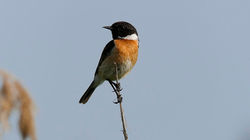 European StonechatSaxicola rubicola ■ Male ■ Apaj, Hungary ■ A tiny flycatcher of open country and farmland. In Central Europe, it is a short distance migrant, arriving early in the spring, leaving late in the fall and spending winters in the Mediterranean Basin. The common name comes from the call which sounds like two stones clacking together. |  Black-winged StiltHimantopus himantopus ■ Bugyi, Hungary ■ You can see where this wader gets its name. Stilts have outrageously long, bubblegum coloured legs which allows them to forage in deeper water than other shorebirds. They are extremely active and noisy, even around nesting sites. |
 Eurasian Scops OwlOtus scops ■ Apaj, Hungary ■ A tiny migratory owl, about the same size as North America’s Saw-whet Owl. It breeds throughout southern Europe and into Western Asia and winters in sub-Sahara Africa. |  Common FirecrestRegulus ignicapillus ■ Szilvásvárad, Hungary ■ A member of the kinglet family, this species along with the related Goldcrest are European smallest birds. It can be found in both coniferous and deciduous woodlands. Like all kinglets, it is constantly moving, flitting among the leaves in search of spiders, small insects, and moth eggs. | 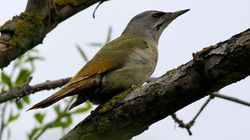 Grey-headed WoodpeckerPicus canus ■ Rétimajor, Hungary ■ This bird belongs to the same genus as the Green Woodpecker but it is not as flamboyant, noisy or famous. It generally likes to stay close to cover and is the most sedate woodpecker I have ever seen. That combination can make it very hard to spot. Like the Green Woodpecker, its diet is primarily ants. |
 Mediterranean GullIchthyaetus melanocephalus ■ Sárbogárd, Hungary ■ This gull’s range used to be the Eastern Mediterranean and Black Sea but it has undergone a huge range expansion westward in recent decades. It is now found breeding as far west as Ireland. Winters along the Mediterranean and Atlantic coasts but for breeding it prefers inland sites. | 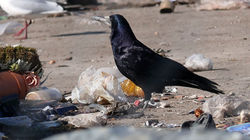 RookCorvus frugilegus ■ Sárbogárd, Hungary ■ A common and highly social corvid found right across Eurasia. Despite the Latin name meaning “fruit eating”, its main food is grubs and earthworms which it digs from the soil using its strong beak. Their large, communal nest sites is where the term “rookery” come from. |  Common MerganserMergus merganser ■ Male ■ Szántod, Hungary ■ Mergansers are ducks but have a very un-ducklike bill. It is narrow with serrated edges and a hooked tip, perfect for gripping slippery fish. |
 Common MerganserMergus merganser ■ Male ■ Szántod, Hungary ■ Mergansers are highly aquatic, fish-eating ducks. As the name suggests, this species is by far the most common of the six extant species worldwide. It has a huge range extending right across the Northern Hemisphere. |  Common MoorhenGallinula chloropus ■ Szántod, Hungary ■ A member of the rail family, Common Moorhens used to be conspecific with North America’s Common Gallinule but are now recognized as separate species. In Hungary, they inhabit marshes with dense reed beds and like to stay in the cover of thick vegetation most of the time. The specific epithet means “green feet”. |  Bewick's SwanCygnus columbianus bewickii ■ Zamardi, Hungary ■ This is the palearctic form of the Tundra Swan. The North American and Asian populations can be separated by the amount of yellow at the base of the bill, with the North American birds only having a small yellow spot in front of the eye. As the Bewick’s form breeds in eastern Siberia, it is rare anywhere in Western Europe. |
 Great Crested GrebePodiceps cristatus ■ Balatonmáriafürdő, Hungary ■ The commonest grebe in Central Europe. This bird is in the drabber winter plumage. Drabber except for the beak, that is. During breeding the bill is a dark grey, but in winter it turns a lovely pink. One way to distinguish it from winter Red-necked Grebes, as the latter species has a yellow beak in winter. |  Common LoonGavia immer ■ Balatonfenyves, Hungary ■ The Common Loon is a North American species that has become more frequent in Europe in recent years. Hungary’s first record was in 2006, but now, even though still rare, there are one or two records every winter. |  House SparrowPasser domesticus ■ Male ■ Balatonszemes, Hungary ■ The House Sparrow was often overlooked or taken for granted by birders because they were so ubiquitous. The European population, however, has dropped in half in the last 40 years. That’s 247 million fewer birds! The usual culprits likely responsible for the decline… habitat loss and industrial farming. |
 Marsh TitPoecile palustris ■ Pátka, Hungary ■ Despite the name, I have never seen this species in a marsh. It prefers deciduous woodlands. It is recognized by the very small bib and by the call. It will join mixed flocks of tits, but you rarely see more than one or two at a time. It doesn’t form large, loose flocks with its own species like you see with Great Tits. |  Hume's WarblerPhylloscopus humei ■ Ocsa, Hungary ■ An Asian species that on rare occasions wanders into Europe, usually during late fall. Members of the Phylloscopus genus are known as leaf warblers and the ID challenge is similar to the Empidonax flycatchers of the Americas. They all look similar and very tough to separate in the field if they are not singing. | 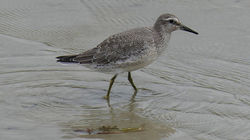 Red KnotCalidris canutus ■ Balatonfenyves, Hungary ■ Named after 11th century Norwegian King Canute, this medium-sized shorebird is another champion migrant. It breeds in the high arctic and migrates all the way to South America, South Africa and Australia for the winter. During breeding season, it is rust coloured but for most of the rest of the year it is a dull grey. The scaly appearance on the back of this individual indicates it is a juvenile. |
 Tree PipitAnthus trivialis ■ Bugyi, Hungary ■ Pipits are small, migratory passerines that like wide open, treeless countryside. This pipit, however, can often be found near trees and along forest edges, hence the common name. One of the field marks of this species is that the streaks along the flanks are much finer than on the breast, compared to the similar Meadow Pipit that has uniform streaks. |  Eurasian KestrelFalco tinnunculus ■ Male ■ Bugyi, Hungary ■ Kestrels are small, open country falcons that eat mostly rodents and large insects like dragonflies. They commonly hover in one place while they search for prey. |  Bar-tailed GodwitLimosa lapponica ■ Balatonfenyves, Hungary ■ This species is a champion migrant with the Alaska breeding populations flying non-stop for 10 days to New Zealand every fall. European birds don’t travel quite so far, breeding in Iceland and Norway and wintering in West Africa. |
 DunlinCalidris alpina ■ Pátka, Hungary ■ One of the commonest and widespread sandpipers in the northern hemisphere. This individual is showing hints of its breeding plumage with traces of rust on the shoulder, cap and ear patch. Most of the year the upperparts are a plain, dull greyish brown. |  Common BuzzardButeo buteo ■ Bugyi, Hungary ■ This is the commonest hawk in much of Europe. It specializes in small rodents but, like most raptors, it is an opportunist. It will steal prey from other raptors and sometimes eat carrion. | 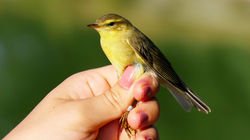 Willow WarblerPhylloscopus trochilus ■ Budapest, Hungary ■ One of the commonest and widespread old world leaf warblers. Juveniles in the fall, like this one, are very yellow, but the yellow fades to only a dull wash on the throat and undertake coverts by the time they acquire their adult plumage. |
 NightingalesBudapest, Hungary ■ Two nightingale species are found in Europe. Left: Common Nightingale (Luscinia megarynchos) found in the western part of the continent. Right: the duller eastern counterpart, the Thrush Nightingale (Luscinia luciscinia). Both are incredible songsters. |  River WarblerLocustella fluviatilis ■ Budapest, Hungary ■ The scalloped appearance on the undertail coverts (due to white feather ends) is a diagnostic field mark of this species. That is, when you can see them. Very difficult to see in he field as they always stay deep under cover, even when singing. |  Savis WarblerLocustella luscinioides ■ Budapest, Hungary ■ A long, dry, insect-like trill coming from dense reed beds indicates a Savi’s Warbler is present. All Locustella species found in Hungary have very long undertail coverts, typically reaching to the end of the tail. This distinctive shape at the back end helps identification when they are not singing. |
 Grasshopper WarblerLocustella naevia ■ Budapest, Hungary ■ A bird of open prairie and scrubland, it eschews anywhere where there are too many trees. Like many warblers in the Locustella genus, it sings like an insect. The soft, high pitched staccato trill can easily be overlooked. |  Garden WarblerSylvia borin ■ Budapest, Hungary ■ Most European Warblers are plain, and this species is the plainest of the plain. What it lacks in bling, though, it makes up for with a robust, rolling song. The faint grey wash behind the ears and across the nape is a characteristic field mark. |  Eurasian BlackcapSylvia atricapilla ■ Budapest, Hungary ■ Male left and female right. One of the commonest European warblers. Largely resident in Western Europe but migratory in the eastern part of the continent. A few can usually be found in winter in Hungary. |
 Eurasian SpoonbillPlatalea leucorodia ■ Rétszílas, Hungary ■ The most widespread of the world’s six spoonbill species, it breeds from Western Europe to Japan and winters in Africa, the Middle East, India and Southeast Asia. |  Great Reed WarblerAcrocephalus arundinaceous ■ Apaj, Hungary ■ This largest European warbler usually delivers its loud, grinding, metallic song from deep in the cover of dense reed beds. The genus name Acrocephalus mans “peaked head”. |  White StorkCiconia ciconia ■ Apaj, Hungary ■ An iconic bird of Hungarian farms and villages, this species has benefited from man’s activity, as forests have been cleared for farmland. It is much more tolerant of human activity compared to Black Storks. |
 European Bee-eaterMerops apiaster ■ Solt, Hungary ■ There are about 30 species of bee-eaters spread across Eurasia and Africa and all of them have spectacular colours. All species are strictly insectivorous. They are partial to bees and are adept at rubbing the bee’s abdomen against a branch or other hard surface to remove the sting before they eat it. |  White WagtailMotacilla alba ■ Kunpeszér, Hungary ■ This small, insectivorous passerine is widespread across temperate Eurasia. It is well named as its long tail is in perpetual motion. |  Western Yellow WagtailMotacilla flava flava ■ Kunpeszér, Hungary ■ The Yellow Wagtail was split into Western and Eastern species several years ago. There are 12 recognized subspecies of the Western Yellow Wagtail. This form, known as the Blue-headed Wagtail is by far the most common form in Central Europe. |
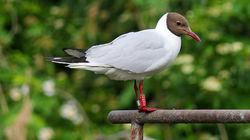 Black-headed GullChroicocephalus ridibundus ■ Rétszílas, Hungary ■ This small gull is the commonest in Central Europe by a huge margin. In Hungary, approximately 75 to 80 percent of all gulls you see will be this species. It is resident but will drift south in the winter if all the water is frozen. |  Purple HeronArdea purpurea ■ Bugyi, Hungary ■ A medium-sized, colourful heron found across southern Eurasia and Africa. The European populations are summer birds, spending the colder months in sub-Saharan Africa. |  Long-tailed TitAegithalos caudatus ■ Apaj, Hungary ■ Twelve siblings just out of the nest. That may seem like a large brood, but this member of the bushtit family has been known to lay up to 20 eggs at one time! Now that’s some parenting! |
 Corn BuntingEmberiza calandra ■ Bugyi, Hungary ■ This is one of the largest buntings in the world, and unlike most other buntings, male and female plumage is identical. Its stuttering trill is an iconic sound of summer on the Hungarian puszta. |  Common WhitethroatCurruca communis ■ Female ■ Kunpeszér, Hungary ■ Lack of a contrasting greyish head identifies this as a female. This species likes open, bushy country and is found across Europe. It winters in sub-saharan Africa. |  Common BlackbirdTurdus merula ■ Male ■ Budapest, Hungary ■ This handsome thrush is in the same genus as the American Robin, and like the latter species, is very comfortable living in close proximity to humans. The commonest thrush in urban parks and gardens in Europe. |
 Ural OwlStrix uralensis ■ Cserépfalu, Hungary ■ Scandinavia and the montane forests of Eastern Europe are the western limit of this owl’s range, which extends right across Siberia and northern China to Japan. It prefers mature forests (either conifer, deciduous or mixed) and the bulk of its diet is voles and other small mammals. |  Red-crested PochardNetta rufina ■ Délegyháza, Hungary ■ This large, flamboyant diving duck is a summer visitor to the Carpathian Basin. Small numbers can be found in the winter but most retreat to southern, sunnier climates during the cold months. The male’s spectacular colours make this species a favorite in zoos and waterfowl collections. |  European StarlingSturnus vulgaris ■ Csákvár, Hungary ■ Because it is such a common bird, we sometimes overlook just how beautiful a starling is in its breeding plumage. There are close to 50 starling species in the world, but this is the only one found in Europe. Same family as the mynas. |
 Grey HeronArdea cinerea ■ Pátka, Hungary ■ People generally don’t think of herons as predators but they are, big time. They are opportunists and will catch and kill anything they can swallow including fish, amphibians, reptiles, rodents and other small birds. |  GoldcrestRegulus regulus ■ Szilvásvárad, Hungary ■ This is the type species for the Regulus genus, the same genus that includes North America’s Golden-crowned Kinglet. Due to its tiny size, drab plumage and weak vocalizations, it is very easy to overlook. It is partial to conifers. |  Red-backed ShrikeLanius collurio ■ Male ■ Apaj, Hungary ■ In late summer, this is one of the commonest birds on the Hungarian puszta but roughly 90% are juveniles like this bird. By September most of the adults have left on their migration to Africa. |
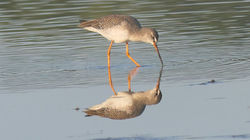 Spotted RedshankTringa erythropus ■ Pátka, Hungary ■ This large shorebird’s pale grey plumage turns jet-black at the height of the breeding season in May/June. Looks very cool but unfortunately the black plumage doesn’t last long. It is probably the most northerly breeder of all Tringa species. |  Common GreenshankTringa nebularia ■ Pátka, Hungary ■ This large shorebird is the Eurasian counterpart to North America’s Greater Yellowlegs. Like most Tringa species, it is a subarctic breeder, wintering in the tropics. The slightly upturned bill is a diagnostic field mark. | 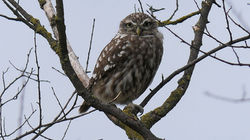 Little OwlAthene noctua ■ Kunpeszér, Hungary ■ Found across Eurasia, this is the commonest owl in the Hungarian farmland. It prefers open country rather than woods, and feeds primarily on small rodents. It is mostly nocturnal but often can be seen out and about during the day. |
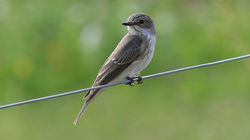 Spotted FlycatcherMuscicapa striata ■ Kunpeszér, Hungary ■ This flycatcher is a common summer resident in Europe but easily overlooked because of its small size, drab plumage and weak vocalizations. It is an easy ID as it is the only European flycatcher with a streaked forehead. |  Red-footed FalconFalco vespertinus ■ Female ■ Dunatetétlen, Hungary ■ A small falcon of eastern Europe and Western Asia, it hunts mostly large insects in open grassland. They migrate all the way to south Africa to spend the winter. Like many falcons, they don’t build their own nest but will take over an old crow, rook or magpie nest. |  European Bee-eaterMerops apiaster ■ Kunpeszér, Hungary ■ There are 27 species of Bee-eaters scattered across Europe, Africa, Asia and Australia and all of them sport spectacular colors. As the name suggests, they specialize in hunting bees and other flying insects. They rub the bee against a hard surface to knock the sting off while applying pressure with the beak to squeeze out the venom. Then it’s down the hatch! |
 Common RosefinchCarpodacus erythrinus ■ Köszeg, Hungary ■ This finch has a huge range extending through much of Eurasia, but it is rare in Western Europe. Hungary is about the western limit of its range, where it is regular but very local. |  Red-backed ShrikeLanius collurio ■ Male ■ Apaj, Hungary ■ This is Hungary’s most common shrike species. It is present during the spring and summer and spends winters in Africa. It feeds primarily on large insects. |  Northern WheatearOenanthe oenanthe ■ Bugyi, Hungary ■ Wheatears are small, open country passerines belonging to the family of old world flycatchers. There are 29 species of wheatear and this one, as the name suggests, is the most northern and the most widespread of all. |
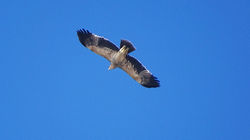 Eastern Imperial EagleAquila heliaca ■ Juvenile ■ Apaj, Hungary ■ Pale brown body, dark flight feathers and tail, fine streaks across the breast and pale “windows” in the inner primaries make an unmistakable flight pattern for young Imperial Eagles. This species is officially referred to as “Eastern” Imperial Eagle only to distinguish it from the Spanish Imperial Eagle (Aquila adalberti). |  European Crested TitLophophanes cristatus ■ Balatonfenves, Hungary ■ In Hungary, this tit is generally found only in large stands of tall conifers. It has a soft, rattling call that is unlike any other European tit. |  Eurasian Blue TitCyanistes caeruleus ■ Kunpeszér, Hungary ■ This is the second most common European Tit after the Great Tit. It is found everywhere from the Mediterranean to subarctic Scandinavia. It prefers mixed deciduous woodlands, and in winter can often be found in marshes and reedbeds. |
 Great EgretArdea alba ■ Apaj, Hungary ■ This is one of the world’s most widespread heron species, being found in North America, South America, Africa, Europe and parts of Asia. |  Northern WheatearOenanthe oenanthe ■ Bugyi, Hungary ■ The parents have gone and now this hatch year bird is left to figure out the migration business on its own. No instruction manual, no Google, no Trip Advisor …. it just has to “wing it”. :D |  Eurasian HobbyFalco subbuteo ■ Kunpeszér, Hungary ■ This smallish falcon is usually found in open country with scattered groups of trees. It is partial to dragonflies, but is fast and agile enough to catch small birds on the wing. |
 Squacco HeronArdeola ralloides ■ Csösz, Hungary ■ This tiny heron is primarily an African species but can be found in the spring and summer in southeast Europe and the Middle East. |  WhinchatSaxicola rubetra ■ Female (left) male (right) ■ Kunpeszér, Hungary ■ This small, colourful passerine is a summer visitor to the Hungarian puszta, wintering in Central Africa. It likes open grasslands with very few shrubs. Like its cousin the European Stonechat, it is now classified as a member of the old world flycatchers (Muscicapidae). |  Black-crowned Night HeronNycticorax nycticorax ■ Soponya, Hungary ■ Widespread on every continent except Australia and Antarctica, this small heron forages for frogs and fish mainly at dawn and at dusk. It is one of the few heron species that have been known to use a baiting technique - tossing small objects in the water to attract fish. |
 Common PochardAythya ferina ■ Female (left), male (right) ■ Apaj, Hungary ■ Although the pochard is a diving duck, it prefers somewhat shallower water than other diving ducks. Despite an extensive range across Eurasia, it is now classified as vulnerable. The population has been declining likely because of habitat loss and overhunting. | 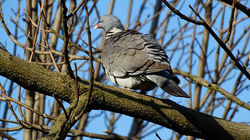 Common Wood PigeonColumba palumbus ■ Törökbálint, Hungary ■ Europe’s largest pigeon is a summer visitor to Central and Eastern Europe but a year round resident in Western Europe, North Africa and Asia Minor. |  RuffCalidris pugnax ■ Male ■ Rétimajor, Hungary ■ This species probably has the most extreme sexual dimorphism of all shorebird species. Big males can be almost double the size of small females. During breeding season, the males develop multi-coloured plumage and a big ruff of feathers around the neck and head, giving the bird its common name. Until recently the species was placed in the monotypic “Philomachus” genus, but is now considered to belong to the typical sandpipers (ie: Calidris genus). |
 Tawny PipitAnthus campestris ■ Kiskörös, Hungary ■ This large pipit is one of only two pipit species that breed in Hungary. They winter in sub-Sahara Africa and the Arabian peninsula. |  Northern Long-eared OwlAsio otus ■ Alsoörs, Hungary ■ In the Carpathian Basin in winter, it is not unusual to find Long-eared Owls roosting in towns and cities. |  Hooded CrowCorvus cornix ■ Balatonfüred, Hungary ■ Many consider the Hooded Crow to be conspecific with Western Europe's Carrion Crow (Corvus corone). |
 Common TealAnas crecca ■ Female ■ Fertőújlak, Hungary ■ Ready to be ringed and then released. Some birders still consider the Common Teal to be conspecific with North America’s Green-winged Teal (Anas carolinensis). |  Eurasian JayGarrulus glandarius ■ Budapest, Hungary ■ One of only two species of jay in Europe. | 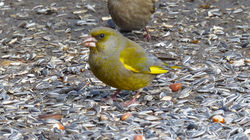 European GreenfinchChloris chloris ■ Budapest, Hungary ■ In the winter, this common European finch is more grey than green. When the spring rolls around, it becomes much more green, and the beak turns pale pink. |
 HawfinchCoccothraustes coccothraustes ■ Budapest, Hungary |  BramblingFringilla montifringilla ■ Budapest, Hungary ■ The moult to breeding plumage, when the head turns from winter grey to jet black, is well underway for this individual. |  Eurasian ChiffchaffPhylloscopus collybita ■ Budapest, Hungary ■ One of the commonest European warblers, its “silt, salt, silt, salt” song is absolutely unmistakable. Being a hardy species, a few can still be found in Europe during mild winters, but most migrate to Mediterranean regions or northern Africa. |
 Northern Lapwing nestVanellus vanellus ■ Bugyi, Hungary ■ While wandering through a flooded farm field in search of Great Snipe, I stumbled upon this lapwing nest. Although the adults were not around, I quicky left the area after snapping a quick photo. |  Northern Long Eared OwlAsio otus ■ Bugyi, Hungary ■ Owls are poor nest builders so they sometimes take over old nests of other species, such as this Long-eared Owl using an old Hooded Crow nest. The white nylon string is a nice decorating touch. :D |  Whooper SwanCygnus cygnus ■ Budapest, Hungary ■ The type species for the genus cygnus, this large swan is widespread across northern Eurasia. |
 Great BitternBotaurus stellaris ■ Apaj, Hungary ■ Bitterns are virtually always under the deep cover of reed beds, but limited open water because of very cold weather can sometimes force them to forage out in the open. |  FieldfareTurdus pilaris ■ Budapest, Hungary ■ Enjoying a bit of peanut butter on a very cold day. This large thrush is a common winter visitor to Hungary. |  GadwallMareca strepera ■ Male ■ Budapest, Hungary ■ This large duck is widespread in both Eurasia and North America. Its latin name (“noisy duck”) is a bit of a misnomer as it is one of the quieter members of its clan. |
 Little BuntingEmberiza pusilla ■ Ocsa, Hungary ■ This smallest bunting in the western palearctic has a huge breeding range extending from Sweden and Finland in the west, to the Bering Sea in the east. It is highly migratory, wintering in Southeast Asia. |  Icterine WarblerHippolais icterina ■ Budapest, Hungary |  Lesser Grey ShrikeLanius minor ■ Kunpeszér, Hungary ■ An eastern European / western Asian bird of high summer, it arrives in May and is gone by August, on its 8,000 km migration to South Africa. |
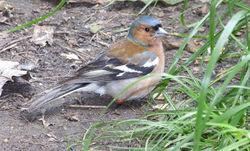 Common ChaffinchFringilla coelebs ■ Tata, Hungary ■ An adult in nice breeding plumage. This is one of the commonest woodland birds in Hungary. |  Little StintCalidris minuta ■ Juvenile ■ Apajpuszta, Kiskunság National Park, Hungary |  Common SnipeGallinago gallinago ■ Apajpuszta, Kiskunság National Park, Hungary |
 European Scops OwlOtus scops ■ Juvenile ■ Kiskunság National Park, Hungary ■ Ready to be returned to the nest box after ringing. |  WryneckJynx torquilla ■ Izsák, Hungary |  Paddyfield WarblerAcrocephalus agricola ■ Farmos, Hungary |
 Penduline TitRemiz pendulinus ■ Male ■ Apajpuszta, Kiskunság National Park, Hungary |  Black-legged KittiwakeRissa tridactyla ■ First winter immature ■ Balatonboglár, Hungary |  Collared PratincoleGlareola pratincola ■ Bugyi, Hungary |
 Collared PratincoleGlareola pratincola ■ Bugyi, Hungary | 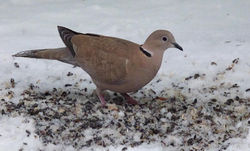 Eurasian Collared DoveStreptopelia decaocto ■ Törökbálint, Hungary ■ Originating in central and southern Asia, the Collared Dove did not expand into Europe until the 20th century, and it is now rapidly expanding across North America. | 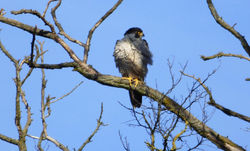 Peregrine FalconFalco peregrinus ■ Zalavár, Hungary |
 Barn SwallowHirundo rustica ■ Hortobágy halastó, Hungary ■ The most widespread swallow species in the world, it is the only member of the 15 species Hirundo genus found in the Americas. |  Blyth's Reed WarblerAcrocephalus dumetorum ■ Izsák, Hungary ■ This eastern Europe / Asian species is very hard to distinguish from the European Reed Warbler in the field if it is not singing. |  DunnockPrunella modularis ■ Naszály, Hungary |
 Common KingfisherAlcedo athis ■ Naszály, Hungary ■ Sometimes if a bird is laid gently on its back after ringing, it will remain motionless like this kingfisher. Just after this shot was taken, the bird flipped over and flew away. |
bottom of page





